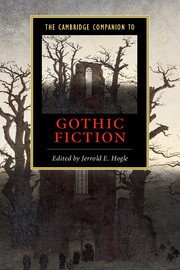Book contents
- Frontmatter
- 1 Introduction
- 2 The genesis of “Gothic” fiction
- 3 The 1790s
- 4 French and German Gothic
- 5 Gothic fictions and Romantic writing in Britain
- 6 Scottish and Irish Gothic
- 7 English Gothic theatre
- 8 The Victorian Gothic in English novels and stories, 1830-1880
- 9 The rise of American Gothic
- 10 British Gothic fiction, 1885-1930
- 11 The Gothic on screen
- 12 Colonial and postcolonial Gothic
- 13 The contemporary Gothic
- 14 Aftergothic
- Guide to further reading
- Filmography
- Index
- Series list
2 - The genesis of “Gothic” fiction
Published online by Cambridge University Press: 28 May 2006
- Frontmatter
- 1 Introduction
- 2 The genesis of “Gothic” fiction
- 3 The 1790s
- 4 French and German Gothic
- 5 Gothic fictions and Romantic writing in Britain
- 6 Scottish and Irish Gothic
- 7 English Gothic theatre
- 8 The Victorian Gothic in English novels and stories, 1830-1880
- 9 The rise of American Gothic
- 10 British Gothic fiction, 1885-1930
- 11 The Gothic on screen
- 12 Colonial and postcolonial Gothic
- 13 The contemporary Gothic
- 14 Aftergothic
- Guide to further reading
- Filmography
- Index
- Series list
Summary
The attachment of the term Gothic to the literature of terror is quite a recent development - and almost entirely accidental. Horace Walpole’s The Castle of Otranto is generally regarded as the first Gothic novel, but when it was published on Christmas Day 1764 it was subtitled simply A Story. The preface puts forward an elaborate counterfeit origin for the text, presenting it as an Italian work printed in 1529 and speculating that it may have been written between 1095 and 1243, at the time of the Crusades, when the story is set. But “Gothic”is nowhere mentioned. It was only when Walpole published a second edition in April 1765 and confessed that it was in fact a modern concoction that the word Gothic was added to the title: The Castle of Otranto: a Gothic Story. The addition was a flippant paradox chiefly intended, one infers, to annoy stuffy critics who objected to the experiment. After all, how could a Gothic story have a modern author?
For Walpole’s contemporaries the Gothic age was a long period of barbarism, superstition, and anarchy dimly stretching from the fifth century ad, when Visigoth invaders precipitated the fall of the Roman Empire, to the Renaissance and the revival of classical learning. In a British context it was even considered to extend to the Reformation in the sixteenth century and the definitive break with the Catholic past. “Gothic“ also signified anything obsolete, old-fashioned, or outlandish.
- Type
- Chapter
- Information
- The Cambridge Companion to Gothic Fiction , pp. 21 - 40Publisher: Cambridge University PressPrint publication year: 2002
- 39
- Cited by

